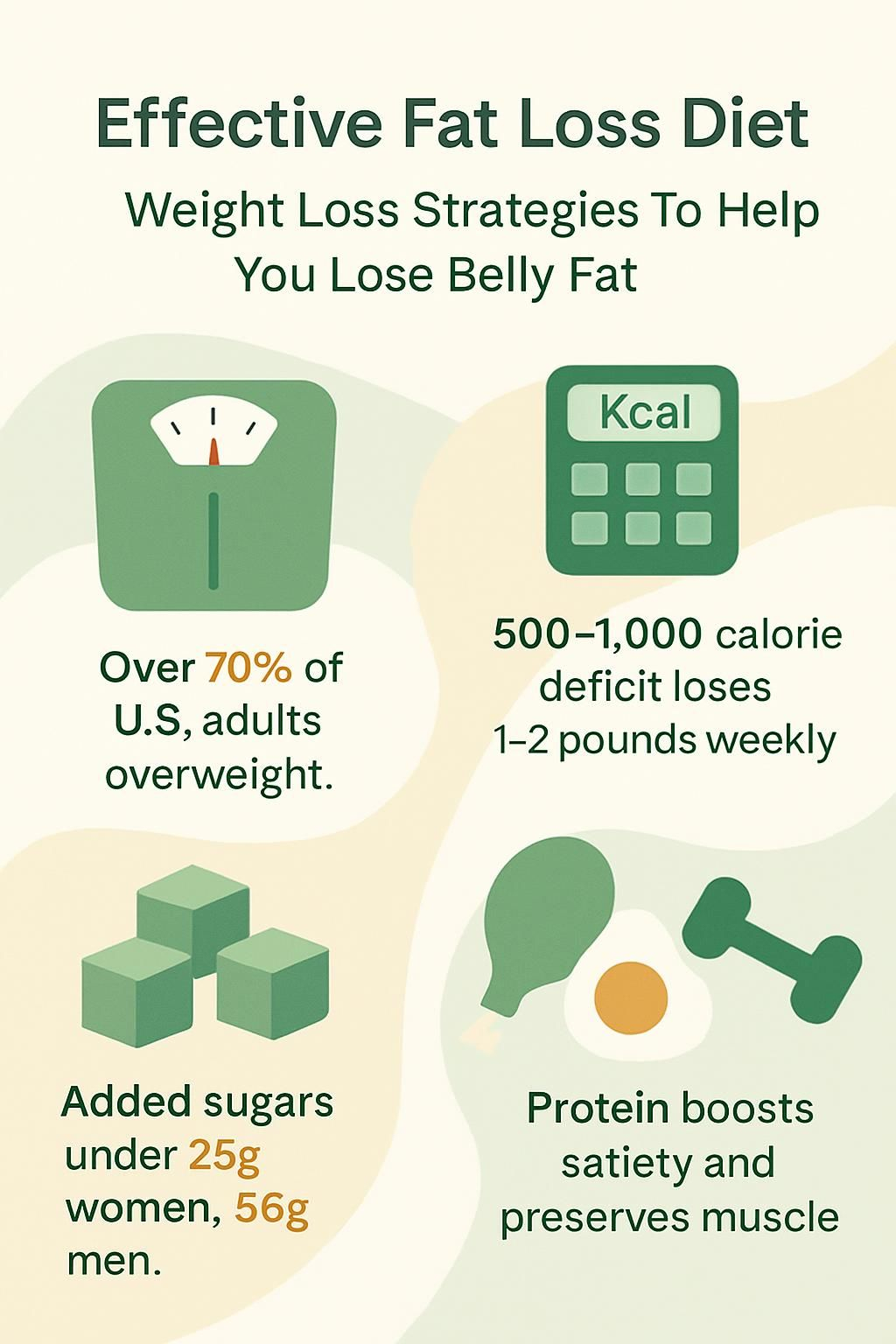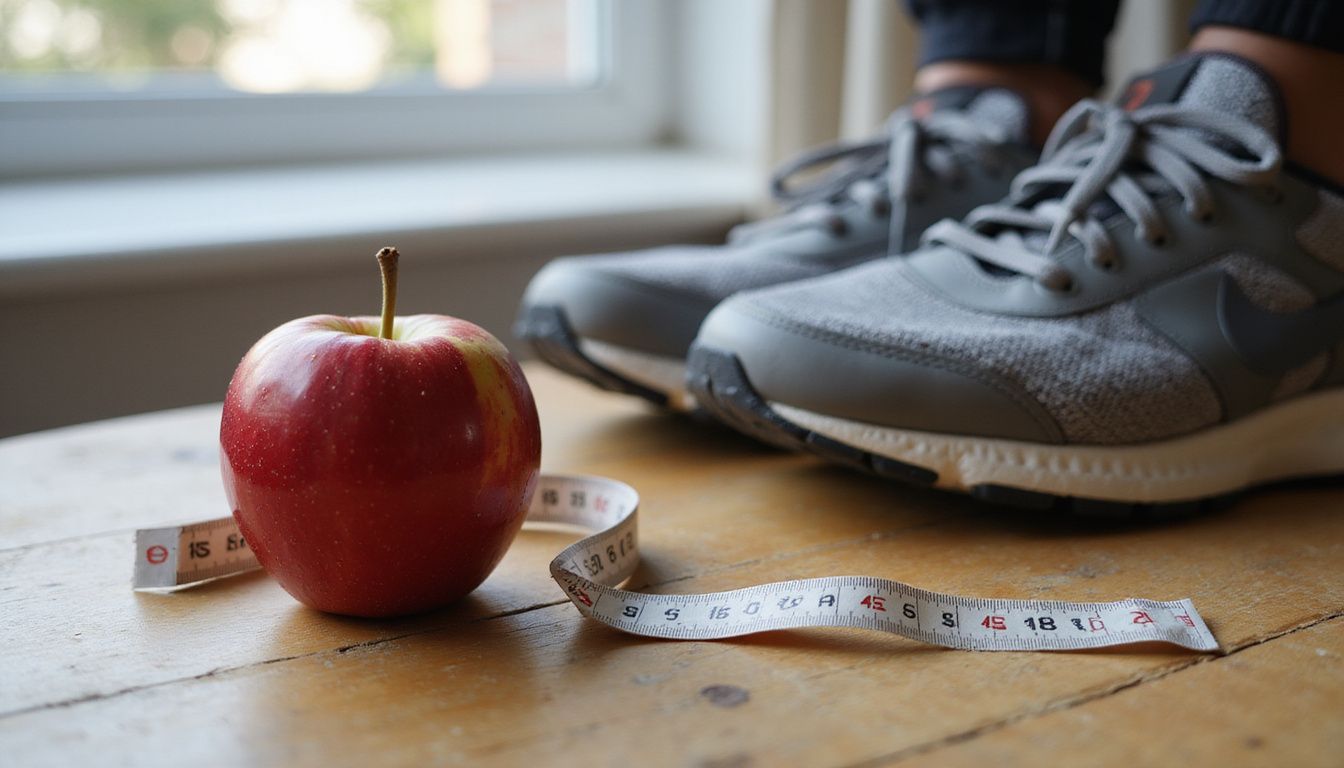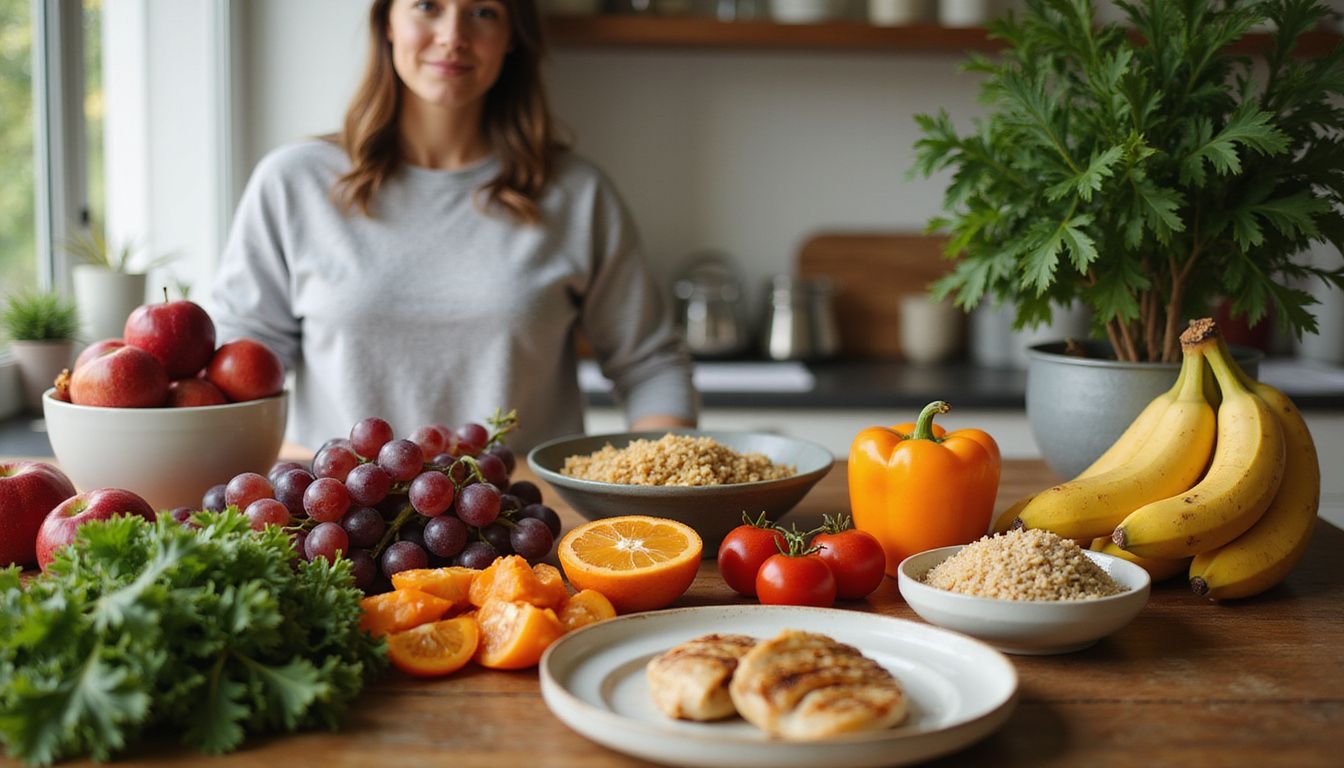Effective Fat Loss Diet: Weight Loss Strategies To Help You Lose Belly Fat
Our Nutrition Assistant AI Suite will transform your body. You will lose fat, get toned, and build muscle. Gain confidence and optimal health.
Trying plan after plan and still not seeing your waist shrink can feel discouraging. In the United States, more than 70 percent of adults live with overweight or obesity, which makes weight loss a common and urgent goal. This guide shows you how a research-based fat loss diet can help you lose belly fat and build habits that last.
You will find clear steps, realistic targets, and tools you can use today. The focus is health first, with steady progress over quick fixes.
Key Takeaways
- Over 70 percent of U.S. adults have overweight or obesity. Effective fat loss strategies can lower risks for heart disease and diabetes.
- A consistent caloric deficit of 500 to 1,000 calories per day helps most people lose about 1 to 2 pounds per week, which the Mayo Clinic considers safe.
- Protein-rich foods, such as Greek yogurt and chicken breast, increase fullness, protect muscle mass, and slightly boost calorie burn during weight loss.
- Cutting processed foods high in added sugar and trans fat reduces belly fat risk. The American Heart Association advises limiting added sugars to 25 grams for women and 36 grams for men per day.
- Combining regular aerobic exercise with strength training increases daily calorie use and supports long-term belly fat reduction, according to CDC guidance.

Understanding Fat Loss and Belly Fat

Fat loss means you reduce extra body fat through food choices and physical activity. Belly fat raises the risk of heart disease, type 2 diabetes, and high blood pressure, so targeting it supports long-term health.
What does fat loss mean?
Fat loss happens when you eat fewer calories than your body burns. Your body then uses stored fat for energy. A steady deficit is the foundation of any effective plan.
Health experts, including the Mayo Clinic, suggest losing 1 to 2 pounds per week for safe and lasting results. Gradual fat loss can improve blood vessel function and sleep quality. It also lowers risk for heart disease and diabetes. Keep the focus on health, not quick fixes.
Why does belly fat build up?
Belly fat often builds when you eat more calories than you use, especially from processed foods high in added sugar and unhealthy fats. Sugary drinks and snacks with trans fat make weight loss harder and promote abdominal fat storage.
Hormones matter too. High sugar intake can raise insulin, a hormone that helps your body store fat around the abdomen. Less movement reduces muscle mass and metabolism, which makes it easier to store extra calories as fat. Stress may raise cortisol, a hormone that encourages belly fat storage.
You might see your waist size increase after weeks of poor sleep and late-night snacking during stressful times at work. Health guidelines note that waistlines above 35 inches for women or 40 inches for men raise risks for chronic disease. Understanding why belly fat builds makes it easier to use a calorie deficit for steady progress.
The Importance of a Caloric Deficit
A caloric deficit is the main driver of weight loss. It is the gap between the calories you eat and the calories you burn each day.
How does a caloric deficit help fat loss?
Your body needs calories for energy. If you eat fewer calories than you use, your body taps stored fat to make up the difference. A deficit of 500 to 1,000 calories per day usually leads to a loss of 1 to 2 pounds per week. Most experts agree this pace supports sustainable weight loss.
Very low calorie plans can cause rapid drops, but they often hurt muscle mass and your metabolic rate. A moderate deficit protects lean tissue while still moving you toward a healthy weight. If strict counting feels hard, use a food diary or app for a few weeks. Or focus on low calorie, nutrient-dense foods such as fruits and vegetables.
Next, learn how to estimate your own calorie needs so your plan fits your life and goals.
How do I calculate my daily calorie needs?
Knowing your calorie needs helps you set targets you can follow. Your needs depend on age, sex, height, weight, and activity level.
- Find your Basal Metabolic Rate, or BMR. Use a calculator or the Harris-Benedict Equation, which uses height and weight.
- Adjust for activity. Multiply BMR by 1.2 if sedentary, 1.55 for moderate activity, and up to 1.9 for very active.
- Use trusted tools, such as the Mayo Clinic Diet tracker, to simplify planning and monitoring.
- Subtract 500 to 1,000 calories from your total to target a weekly loss of 1 to 2 pounds, as health agencies recommend.
- Align calories with your goals. Increase protein if you want to protect muscle mass while losing body fat.
- Track progress with a journal or app. Adjust your intake if your rate of loss is too fast or too slow.
- Talk with your healthcare provider before major changes if you have conditions like hypertension, sleep apnea, liver disease, or heart risks.
Nutrient-Rich Foods for Fat Loss
Choosing nutrient-dense foods makes a diet for weight loss easier to follow. The right mix keeps you full, protects muscle, and supports energy.
Which fruits and vegetables aid fat loss?
Fruits and vegetables give volume, fiber, and hydration for very few calories. Many programs, such as the Mayo Clinic Diet, encourage at least five servings per day.
- Leafy greens like spinach, kale, and romaine are low in calories but high in fiber and water, which boosts fullness.
- Berries provide antioxidants and natural sweetness with less sugar than many other fruits.
- Grapefruit may help steady blood sugar after meals. Several studies link routine intake with improved fat loss.
- Cruciferous vegetables such as broccoli, cauliflower, and cabbage deliver fiber and key micronutrients for digestion and satiety.
- Apples and pears contain soluble fiber, which slows digestion and supports appetite control.
- Carrots, cucumbers, celery, and bell peppers make simple, low calorie snacks rich in vitamins and minerals.
- Tomatoes offer lycopene, a compound linked with lower inflammation that may support loss around the abdomen.
- Avocados contain healthy monounsaturated fat. They help you feel full longer, even in a plant-based eating pattern.
- Oranges and other citrus fruits provide vitamin C and hydration that support overall metabolism.
- Zucchini works as a pasta swap that reduces calories without spiking blood sugar.
You can make progress with small swaps. For example, prepare a big salad with leafy greens at lunch and snack on raw vegetables instead of chips.
What are the best lean protein sources?
Lean protein curbs hunger and helps protect muscle during weight loss. It also raises the calories you burn during digestion, which supports your daily deficit.
- Skinless chicken breast is high in protein and low in fat. A typical serving offers about 27 grams of protein.
- Fish like salmon or tuna adds protein and omega-3 fatty acids, which support heart health.
- Eggs provide complete protein and healthy fats, which support fullness and steady energy.
- Beans such as lentils or black beans offer plant protein plus fiber for appetite control.
- Low fat Greek yogurt delivers about 20 grams of protein per cup and supports bone health with calcium.
- Turkey breast works well for sandwiches and salads with very little saturated fat.
- Tofu or tempeh gives plant-based protein for people who choose vegetarian options.
- Lean beef cuts like sirloin or round can fit sometimes. Trim visible fat to limit saturated fat.
Simple shifts make a difference. Replace processed meats with grilled chicken or fish on most days to support better body composition.
How do healthy fats support fat loss?
Healthy fats from olive oil, avocado, nuts, and seeds help control hunger and support heart health. Diets like the Mediterranean diet use plant oils in place of butter or margarine to lower saturated fat intake.
Replacing saturated fat with unsaturated fat can improve cholesterol levels and reduce cardiovascular risk. Healthy fats also help your body absorb fat-soluble vitamins A, D, E, and K. Better insulin sensitivity and reduced belly fat have been seen when these fats replace less healthy options.
Practical tip: cook with olive oil and add a small portion of nuts to meals for extra satisfaction without overdoing calories.
Why include whole grains in your diet?
Whole grains like brown rice, quinoa, oats, and whole wheat bread provide steady energy and fiber. They also supply minerals such as magnesium and iron.
Many healthy eating patterns, including DASH and the Nordic diet, place whole grains at the core. The Mayo Clinic Healthy Weight Pyramid also supports frequent whole grain intake. Eating at least three servings per day can reduce hunger and support belly fat loss over time.
If morning hunger hits early, choose oatmeal or whole grain cereal. You will likely feel full longer and snack less before lunch.
Fat-Burning Foods to Include in Your Diet
Think of this list as a simple starter kit for foods that nudge your metabolism in the right direction.
How does green tea help burn fat?
Green tea can slightly boost your metabolism. Its antioxidants, called catechins, especially EGCG, work with caffeine to increase the calories you burn. Studies show daily green tea drinkers may burn 3 to 4 percent more calories across the day.
Replacing sweetened drinks with two or three cups of unsweetened green tea can support your eating plan. Many people also report less bloating and steadier energy during exercise.
Why is Greek yogurt good for fat loss?
Greek yogurt is high in protein and lower in sugar than many flavored yogurts. That mix helps you feel full longer, which supports a caloric deficit without feeling deprived.
The calcium in Greek yogurt may also help reduce fat mass in some people. Choose plain nonfat or low fat versions and add fruit for natural sweetness.
Can hot peppers boost metabolism?
Hot peppers contain capsaicin, a compound that can temporarily raise your metabolism. Several studies suggest capsaicin increases energy use and may reduce appetite for a short time. One trial reported an average of about 50 extra calories burned per day among regular chili pepper eaters.1
Chopped jalapeños or a sprinkle of cayenne can make salads or soups more satisfying for very few calories. Small, steady changes like this may support long-term weight management.
1 Yoshioka M., et al., British Journal of Nutrition, 2019.
What makes quinoa a fat-burning food?
Quinoa is a whole grain seed rich in both protein and fiber. One cup cooked provides about 8 grams of protein and 5 grams of fiber. That combination supports fullness and steadier blood sugar, which helps you eat fewer calories overall.
More muscle means a higher resting metabolism. The protein in quinoa supports muscle repair, while the fiber supports gut health and may help lower blood pressure. Add quinoa to bowls, salads, or soups several times a week.
Effective Dietary Strategies for Belly Fat Reduction
Smart food choices help you chip away at belly fat while keeping your energy stable.
How does soluble fiber reduce belly fat?
Soluble fiber forms a gel in your gut. This slows digestion and helps you feel full longer, which can lower total calorie intake. Research shows that eating at least 10 grams of soluble fiber per day can cut visceral fat, the fat around your organs, by up to 3.7 percent over five years.
Good sources include oats, apples, beans, carrots, and citrus fruits. A bowl of oatmeal or an apple with skin at breakfast is a simple way to start.
Why should I avoid trans fats?
Trans fats raise belly fat and harm heart health. They increase LDL, the bad cholesterol, and reduce HDL, the good cholesterol. Many packaged snacks and baked goods contain trans fats.
Check labels for partially hydrogenated oils, a common source of trans fats. Choosing whole foods and simple ingredient lists helps you control your intake and supports long-term health.
What are the effects of added sugars and processed foods?
Processed foods often pack added sugar and excess sodium. High sugar intake is linked with more belly fat and a higher risk of insulin resistance and type 2 diabetes. The American Heart Association suggests limiting added sugar to 25 grams for women and 36 grams for men per day.
Choosing nutrient-dense options steadies blood sugar and energy. Swapping sugary cereal for oats with nuts and fruit can reduce midday crashes within a couple of weeks.
How does alcohol consumption impact belly fat?
Your body prioritizes clearing alcohol, so fat burning slows while it processes the drink. Extra calories from alcohol are often stored as belly fat. People who drink moderate to high amounts are more likely to carry visceral fat around their organs.
One glass of beer or wine has about 120 to 150 calories with little nutritional value. Cutting back can reduce bloating and help your body metabolize fat more efficiently. Many people notice a smaller waist after several weeks of reduced intake.
The Role of Protein in Weight Loss
A higher protein intake supports appetite control, muscle protection, and a small boost in daily calorie burn.
What are the benefits of high protein diets?
Protein helps you feel full longer, so it is easier to meet your calorie goals. It also protects lean muscle while you lose weight. Keeping muscle matters because muscle burns more energy at rest than fat tissue.
You burn more calories digesting protein than carbs or fat. Many people find that Greek yogurt, eggs, poultry, fish, and beans help them stay satisfied between meals.
| Diet Type | Lean Muscle Lost (average) | Fat Loss Higher With |
|---|---|---|
| Low Carb, High Protein | 2 to 3 pounds | Higher |
| Low Fat | 2 to 3 pounds | Lower |
In short, adequate protein helps control hunger, protects muscle during fat loss, and slightly increases calorie burn.
Which lean proteins are best for weight loss?
Lean proteins are the backbone of a solid weight loss plan. They support fullness and muscle health.
- Grilled chicken breast supplies high quality protein with very little fat.
- Fish such as salmon, cod, or tilapia provides lean protein and helpful omega-3 fatty acids.
- Eggs deliver complete protein and vital nutrients for daily function.
- Beans give plant protein and fiber that aid appetite control.
- Greek yogurt offers about twice the protein of regular yogurt for similar calories.
- String cheese with an apple is a quick snack that pairs protein with fiber.
- Turkey breast is an easy lean option for salads, wraps, or soups.
These choices fit well into a high protein plan that aims to reduce belly fat while maintaining muscle mass.
The Importance of Staying Hydrated
Water supports your metabolism and helps your body use stored fat for energy.
How does drinking water help with fat loss?
Water can increase your resting energy use for a short time. Drinking two glasses may raise calorie burn by up to 30 percent within 10 minutes, and the effect can last about an hour. In one study, people who drank water before meals lost about 44 percent more weight over 12 weeks than those who did not.
Hydration also helps you feel full. Regular water intake can reduce snacking and supports steady energy during workouts or fasting windows. Water has zero calories, which makes it an easy win for anyone focused on fat loss.
What are easy ways to increase water intake?
Simple habits can help you drink more water throughout the day.
- Carry a reusable bottle so water is always within reach.
- Drink a glass before every meal or snack to support appetite control.
- Swap sugary drinks for water, unsweetened tea, or black coffee.
- Set phone reminders to take regular sips.
- Add lemon, cucumber, or mint if you prefer flavored water.
- Start your morning with a cold glass to rehydrate quickly.
- Track intake with an app to reach about eight 8-ounce glasses daily, unless your doctor advises otherwise.
- Order water first at restaurants and sip it through the meal.
- Choose water-rich foods like soup, oranges, and celery for extra hydration.
These steps support healthy hydration, which makes your fat loss plan easier to maintain.
Optimal Meal Timing Strategies
Smart timing helps your body manage hunger and energy, a bit like setting a steady rhythm for your day.
Why is eating breakfast important for fat loss?
A balanced breakfast helps control appetite and supports steady energy. Skipping it often leads to strong hunger and overeating later. People who eat breakfast, such as bran flakes with fruit, nuts, and milk, usually make better choices the rest of the day.
Starting your day with a meal helps your metabolism after an overnight fast. Research from 2022 links eating breakfast with more consistent weight loss than skipping it.
How can avoiding late-night eating aid weight loss?
Finishing your last meal by 8:00 p.m. helps limit extra night-time calories and aligns with your body’s natural clock. Late eating often leads to snack foods and larger portions. Insulin sensitivity is higher earlier in the day, which may reduce fat storage when you eat earlier.
Many people find that ending meals several hours before bed improves sleep and cuts cravings. Setting a kitchen cut-off time can help you maintain a calorie deficit without feeling restricted.
Exercise and Physical Activity for Fat Loss
Exercise adds fuel to your fat loss efforts. It increases daily calorie burn and improves health markers.
Which aerobic exercises burn fat effectively?
Aerobic exercise supports your caloric deficit and targets belly fat. Aim for 30 to 60 minutes of moderate to vigorous activity on most days.
- Brisk walking raises heart rate and improves insulin levels. A daily 30-minute walk can help your body use stored fat for fuel.
- Running burns many calories per minute. Thirty minutes can use 240 to 355 calories depending on pace and body size.
- Cycling is low impact and effective. One hour at moderate intensity can burn 400 to 600 calories for many adults.
- Swimming works many muscles while being gentle on joints. Thirty minutes of laps can use 300 calories or more.
- Jump rope challenges your cardio system and coordination. Ten fast minutes can match an eight-minute mile.
- Dance classes like Zumba make steady cardio fun and social.
- Rowing targets upper and lower body muscles while raising calorie burn.
If your schedule is tight, a daily brisk walk with your dog can keep you consistent without a gym membership.
How does strength training support fat loss?
Strength training builds lean muscle, which burns more calories at rest than fat tissue. Research from the Harvard School of Public Health found that 20 minutes of weight training daily can reduce fat gain over time compared with aerobic activity alone.
Even two short full body sessions per week can help. Many people notice their clothes fit better as muscle increases and belly fat decreases.
What are simple ways to add daily movement?
Short movement bursts add up and support steady weight loss.
- Take the stairs whenever you can for quick calorie burn.
- Park farther away to add more steps to your day.
- Walk during phone calls or virtual meetings.
- Get off public transit one stop early and walk the rest.
- Do squats, lunges, or jumping jacks during TV breaks.
- Set hourly reminders to stand and stretch if you sit often.
- Try a standing desk for part of your workday.
- Make activity social, like evening walks with family.
- Join a weekly class to build routine and accountability.
- Start with 5 to 10 minutes if you are inactive, then build toward 30 minutes most days.
These actions increase daily energy use without major schedule changes or strict programs.
Lifestyle Changes to Support Fat Loss
Small lifestyle shifts can multiply your results and make your plan stick.
How does reducing stress help with fat loss?
Lower stress can reduce cortisol, a hormone that encourages belly fat storage. Stress also drives cravings for high calorie foods. Practices like deep breathing, short walks, or brief workouts help you manage stress and avoid emotional eating.
Mind and body work together. Better stress control supports consistent food choices and more stable progress.
Why is improving sleep quality important?
Poor sleep raises hunger hormones, which can drive cravings and overeating. It can also slow your metabolism and increase belly fat. In one study from 2022, people sleeping less than six hours per night had a 22 percent higher chance of weight gain than those sleeping seven or more hours.
Losing just five percent of your body weight can improve sleep quality. Better sleep makes it easier to choose healthy foods and stay active.
How can avoiding sedentary habits aid weight loss?
Sitting less boosts daily calorie burn. Stand up every hour, walk during calls, and use stairs when possible. These small choices build a healthy routine and reduce belly fat over time.
For example, a 30-minute walk may burn about 150 calories for someone who weighs around 155 pounds. Those calories add up across weeks and months.
Common Mistakes to Avoid
A few missteps can stall progress. Knowing them helps you adjust quickly and stay on track.
Why are fad diets and crash diets harmful?
Crash diets can cause fast drops on the scale, but much of that is water and sometimes muscle, not fat. These plans often cut entire food groups and miss key nutrients. The Mayo Clinic warns that short-term fixes rarely teach healthy habits.
Stopping a crash diet usually leads to rapid regain, often called yo-yo dieting. You may also feel headaches, fatigue, a slowed metabolism, and digestive trouble. A balanced plan with steady changes works better for lasting results.
What are realistic expectations for weight loss?
Set a target of 1 to 2 pounds per week after an initial drop. The Mayo Clinic Diet notes that many people lose 6 to 10 pounds in the first two weeks, then settle into a steady pace.
This approach protects your muscle mass and focuses on abdominal fat reduction over time. A clear plan with small weekly goals can prevent burnout and support long-term success.
Why should I avoid skipping meals?
Skipping meals can lead to overeating later and disrupt your metabolism. People who skip breakfast often choose higher sugar or higher fat foods later in the day.
Regular, balanced meals help keep energy steady and reduce late-night snacking. For most people, this routine supports sustainable fat loss.
Tips for Long-Term Success
Steady habits, simple tracking, and regular support make weight management easier to maintain.
How can I track my fat loss progress?
Use digital tools from trusted programs, such as the Mayo Clinic Diet, to log meals, workouts, and weight trends. These records help you see patterns and adjust your plan.
Pay attention to how your clothes fit and track waist size every two weeks. Many people see inches drop before the scale moves much. Progress photos in similar clothes and lighting can also help you spot changes.
Why is consistency with small changes key?
Gradual changes are easier to keep and reduce the chance of burnout. The Mayo Clinic Diet suggests adding five healthy habits, breaking five unhealthy ones, and adopting five bonus habits. Start with small actions, such as drinking one extra glass of water or swapping candy for fruit.
Research shows people who build habits slowly keep the weight off more often. A short walk after lunch each day can be enough to move your waistline in the right direction.
How does support from others improve success?
Support from friends, family, or a group can raise your success rate. People who get regular encouragement tend to lose more weight and maintain it longer. Sharing progress with a partner increases accountability and motivation.
Even one supportive person can improve your odds of reaching your goals. Plan workouts together or trade simple meal ideas to stay consistent.
Sample Fat Loss Meal Plan
Use these meal ideas as a flexible template. Adjust portions to fit your calorie target and activity level.
What is a healthy breakfast example?
Overnight oats with berries and sliced pear offer fiber, vitamins, and hydration. Oats support digestion and fullness. Berries add antioxidants with natural sweetness. Pears provide extra fiber and fluid.
Or try bran flakes with strawberries, walnuts, and nonfat milk. Whole grains help steady blood sugar. Walnuts add healthy fats for satiety. Milk supplies protein for muscle support.
What should I eat for lunch?
Tuscan white bean soup with a light drizzle of pesto gives plant protein and fiber for fullness and digestive health. Beans are nutrient dense and low in fat.
A turkey sandwich on whole wheat with spinach, tomatoes, and cucumbers is another strong option. Use olive oil and vinegar instead of mayonnaise for healthier fat and fewer calories.
What is a good dinner option?
Sheet-pan roast chicken with broccolini, onions, and tomatoes provides lean protein and fiber-rich vegetables with simple cleanup. Control added oils to match your calorie target.
Salmon with sautéed spinach offers heart-healthy omega-3 fats, iron, and vitamin C. Many people find this combination keeps them full without heavy evening calories.
What are healthy snack choices?
Smart snacks help you stay in a caloric deficit while giving your body the nutrients it needs.
- One cup sliced bell peppers, about 24 calories, and rich in vitamin C.
- One banana, about 105 calories, with potassium and quick energy.
- A small handful of almonds or pistachios, about 160 to 180 calories per ounce, with healthy fats and fiber.
- Plain nonfat Greek yogurt, about 100 calories per serving, for protein and fullness.
- String cheese with an apple for a mix of protein, calcium, and fiber.
- Peanut butter on half a banana for healthy fat, carbs, and protein.
- Raw carrots or cucumbers with hummus for fiber and plant protein.
- Keeping these options ready makes it easier to skip processed snacks high in sugar or trans fat.
FAQs About Fat Loss Diets
You may have questions as you build your weight loss plan. Here are direct answers based on current evidence.
How fast can I safely lose belly fat?
Safe progress is steady, not extreme. The Mayo Clinic Diet notes many people lose 6 to 10 pounds in the first two weeks of structured changes. After that, a pace of 1 to 2 pounds per week is common and safe.
Very fast loss often reflects water or muscle drops, not just belly fat. A balanced plan and moderate deficit protect your energy and health while you reduce abdominal fat.
Can I target fat loss in specific areas?
Spot reduction is a myth. You cannot choose exactly where your body loses fat first. Research from the American Council on Exercise shows that ab exercises strengthen muscles but do not remove fat from one area without total body loss.
Create a caloric deficit and combine strength training with aerobic exercise. Over time, your waistline will shrink as visceral fat decreases across your body.
Conclusion
Choosing an effective fat loss diet puts health first while helping you lose belly fat at a steady pace. Emphasize nutrient-rich foods, lean protein, healthy fats, and whole grains. Limit processed foods and added sugar. Pair these choices with smart hydration, strength training, and regular aerobic exercise.
Set realistic goals, track simple metrics like waist size, and ask for support when needed. If you have medical conditions, consult a healthcare professional before major changes. Small daily actions build strong habits, which makes long-term weight loss and weight management far more likely.
FAQs
1. What is the most effective fat loss diet for reducing belly fat?
A balanced eating plan that includes lean proteins, whole grains, vegetables, and healthy fats supports weight loss. Studies show diets high in fiber and protein help reduce abdominal fat more than low-protein or low-fiber plans.
2. How many calories should I eat daily to lose weight safely?
Most adults need a calorie deficit of 500 to 750 per day for steady weight reduction, which usually results in losing about one to two pounds each week. The Dietary Guidelines for Americans recommend not dropping below 1,200 calories per day for women or 1,500 for men unless supervised by a health professional.
3. Are there specific foods proven to help burn belly fat faster?
Research suggests that foods rich in soluble fiber like oats and legumes can lower visceral fat over time. Protein-rich options such as poultry or fish also support muscle retention during calorie restriction; this helps maintain metabolic rate while targeting body mass reduction.
4. Can exercise alone lead to significant belly fat loss without changing my diet?
Physical activity increases energy use but combining regular movement with an evidence-based eating pattern leads to greater reductions in waist size compared with exercise alone. For example, after adding brisk walking and adjusting meal portions last year, I noticed measurable changes around my midsection within three months.
Summary: Effective strategies include following a nutrient-dense meal plan focused on protein and fiber intake while maintaining an appropriate calorie deficit alongside consistent physical activity; these methods are supported by research findings on sustainable weight management and abdominal circumference reduction.







